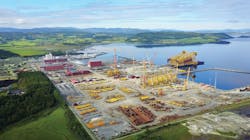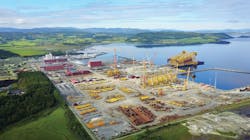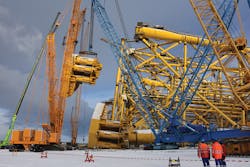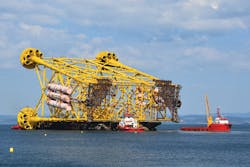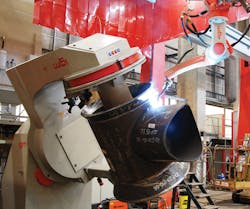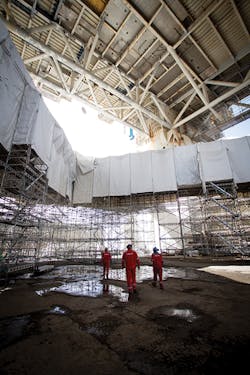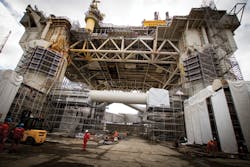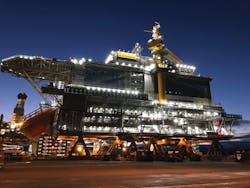Kvaerner adapts construction methodology for giant Johan Sverdrup jackets
Additional quayside investment to accommodate FPSOs
Jeremy Beckman, Editor, Europe
Over the past three years, Kvaerner’s yards in Norway have supported various major greenfield and life extension programs across the Norwegian continental shelf. Highlights include an unprecedented level of jacket activity at Verdal, exclusively for the Johan Sverdrup project.
At Stord, a new crane is helping to speed up topsides assembly, and a quayside extension, currently under construction, will allow the yard to accommodate floating platforms, including the Johan Castberg FPSO.
Offshore spoke to Tove Strand Trana, Head of Communications for Kvaerner’s Structural Solutions business, and Odd Naustdal, Head of Communications for Process Projects, about these developments.
***
Offshore: Johan Sverdrup will feature five of the North Sea’s largest platforms, and Equinor contracted Kvaerner to build four of the jackets. What was the thinking behind this decision?
Trana: Prior to the contract award, Kvaerner and Equinor (then Statoil) had established a frame agreement for jacket deliveries across the Norwegian continental shelf [NCS], which Equinor could call on for any upcoming project. When it came to issuing the engineering, procurement, and construction (EPC) contracts for the Phase 1 Johan Sverdrup four-platform complex, the partners decided to exercise the frame agreement with Kvaerner for the drilling platform and riser platform jackets. Subsequently Kvaerner also won an open bid competition for the process platform jacket.
Kvaerner’s yard in Verdal.
(All photos courtesy Kvaerner)
When negotiating the delivery, one of the objectives was to improve the total price so that these new jackets would cost less than jackets in the recent past. One of the key factors to achieving this was that Kvaerner could take a long-term perspective on investments in the yard facility, training of personnel, and so on. The company could also leverage larger volumes with respect to procurement of material and services from subcontractors. The work flow for all three jackets could therefore be planned as one overall execution plan, and this enabled an industrial approach to much of the scope, including harvesting of ‘copy-effects’ and series-production for parts of the work where this was possible. Also, with Kvaerner as a single contractor for the three largest jackets for Phase 1, Equinor could, as the customer, organize follow-up very effectively.
In July 2018, the third of the first three jackets was delivered. All have been dispatched on schedule, to the agreed quality, and the objectives for cost improvements have been met.
Lifting of pile cluster.
Offshore: What investments did the company have to make to the Verdal site to undertake a program of this scale?
Trana: The same Kvaerner project team was in charge of construction and delivery of all three steel jackets throughout 2014-2018. The company invested in three crawler cranes at Verdal for the assembly phase, and in welding robots and mechanized welding systems that were used during both prefabrication and assembly of the three jackets.
Offshore: Was it necessary to work with materials suppliers in a new way to ensure compliance with deadlines and delivery schedules?
Trana: Yes, to effectively integrate procurement and deliveries from subcontractors into one effective delivery model is critical for an EPC contractor. For this particular project, which called for delivery of three of the largest jackets to date in the North Sea (the riser platform jacket is the region’s largest), effective procurement of materials with the right quality was a vital part of the total project execution. At one time, in the summer of 2017, 65,000 metric tons [71,650 tons] of steel for the three jackets had to be stored onsite at Verdal.
Offshore: Were the jackets designed to simplify offshore installation, and do they have other features to assist hook-up operations or to ensure longevity of service?
Trana: Kvaerner’s in-house engineering department for jacket design is internationally recognized for optimizing design to fit a project’s special requirements. The three first jackets for Johan Sverdrup weigh in the range 18,000-24,000 metric tons [19,842-26,455 tons], and were designed to be launched from transport barges. However, the fourth (and currently) final jacket that the company will supply for this project, the recently awarded Phase 2 P2 substructure, is being designed to be lift-installed – with a weight of 12,000 metric tons [13,228 tons], this will be the heaviest ever lift installation of a jacket anywhere. For this project, the company has applied its experience in design to combine cost reductions with other project-specific criteria, such as operational lifetime, topsides weight and local conditions at site. The corrosion protection/surface treatment system for the jackets is standard, as for most jackets delivered to the NCS.
Johan Sverdrup process platform jacket.
Offshore: What lessons has Kvaerner taken onboard from Phase 1 to improve construction of the Phase 2 platform jacket? Can you explain how, as the company claimed last year, it can now manufacture large jackets at lower cost than in 2005?
Trana: In early 2013, almost two years before the oil price dropped, Kvaerner embarked on a program of reducing costs and increased productivity. One of the first steps was to establish a more comprehensive measuring and benchmarking of costs and productivity throughout the entire work-flow and value chain in a project. It identified high-priority improvement areas and implemented actions, measured and benchmarked again, and then repeated the process with further improvements. It also leveraged learnings from other business sectors that had adopted sophisticated industrialization, and transferred this industrialization approach to the oil industry where traditionally there had been a project-to-project focus, with improvements primarily instigated for individual projects. The net effect of these actions was that in 2016, the company had reduced the cost base for new deliveries by around 25%; for jackets, the cost level is now down to what was on offer in 2005.
Throughout the North Sea offshore construction industry cost reductions and productivity improvements have come into full force since 2014-2015. The latest version of the Norwegian Konkraft Report, published in January 2018, concluded that the industry in general had improved in both respects by about 25% but needed to improve further by around the same magnitude before 2022. Konkraft is a permanent joint effort between oil companies operating in Norway, the Norwegian supply industry, Norwegian labor unions and others, with the purpose of defining initiatives to cut costs and improve productivity. Kvaerner is an active partner in this initiative.
Welding robot.
Offshore: What other changes and investments has the company taken to streamline fabrication processes at Stord, and what is the status of this yard’s other offshore projects?
Naustdal:Kvaerner has invested around NOK350 million [$40 million] in Northern Europe’s largest crane for the facility at Stord, and has also committed NOK370 million [$42.5 million] to expanding facilities for this crane and the quayside. The crane provides the capability to lift and install a large module, after all systems and equipment have been integrated into the module at ground level where this work can be performed with maximum efficiency. Being able to plan execution of a project to include rapid installation of large and complete modules leads to significant cost reductions, higher productivity, and most importantly, improved HSE.
The Njord field semisubmersible platform at the Kvaerner Stord yard.
The yard started to use the new large crane in 2014 for the final phases of Lundin Norway’s Edvard Grieg project in the North Sea, although the execution model for the Edvard Grieg platform was designed to suit the capabilities of the previous (smaller) crane. The company applied this benchmark when it started to plan the execution of the Johan Sverdrup Utility and Living Quarter (ULQ) topsides, which does involve use of the large crane.
The ULQ passed the milestone of mechanical completion on Oct. 1, 2018, exactly on schedule, and will be towed to the field towards the end of 1Q 2019. The program has met all objectives for improved productivity using the large crane as an integrated part of the model for project execution and assembly of the topsides. In parallel, learnings and benchmarks from Edvard Grieg and the ULQ have been applied to the ongoing work to upgrade the Njord A semisubmersible production platform. And the benchmarks from all these projects will also be transferred to the fabrication of the topsides of the Johan Castberg FPSO for the Barents Sea.
Kvaerner Stord is upgrading the Njord A semisubmersible production platform, which started production in 1997 in the Haltenbanken area of the Norwegian Sea. The program is designed to keep the facility operating on the Njord field for a further 20 years, and includes new facilities to enable tie-ins of other oil and gas fields in the region.
Offshore: Kvaerner is using the L ALPHX Digital process for different aspects of the offshore construction process. What are the benefits?
Naustdal:This is a digital system which allows the company to use AI (artificial intelligence) to engineer structures, including jackets or scaffolding. The basis for the system is databases from dozens and dozens of previous projects combined with the methodology the company applies when designing new jackets, or when there is a need to design comprehensive scaffolding for use during work with a platform or onshore plant.
The system is in use presently for various projects, one being for the extensive scaffolding around the hull of the Njord A platform which is undergoing upgrading for 20 new years of operation in the Norwegian Sea (Kvaerner is the EPC contractor for this project) and which is due to be completed in 2020. As for application on future jacket projects, the company is in dialogue with customers and will consider whether there are opportunities that might benefit from this process.
The Johan Sverdup Utility & Living Quarter topsides contains the control center for the entire Johan Sverdrup field complex. The Kvaerner/KBR joint venture has been working on the topsides under an EPC project, and the structure will be delivered from Stord in March for transportation to the field center.
Offshore: A new deepwater quayside is under construction at Stord, the main purpose being able to accommodate FPSOs of varying designs, including Johan Castberg’s. What are the benefits?
Naustdal:This expansion includes prolonging of both crane tracks for the traverse crane which will enable the crane to move further and to cover a wider/longer area, for example, to install topsides modules on a long FPSO. Additionally, it will allow the crane to work on two topsides located next to each other if neither is for a long ship-shape FPSO, i.e. for one circular FPSO and for one semisubmersible platform, or other similar combinations. The ongoing investment will also expand the quay area, which will facilitate lining up of modules and equipment for effective lifting.
Kvaerner has at Stord one of the world’s state-of-the-art facilities for decommissioning and recycling of old offshore structures. We typically recycle or re-use around 99% of the structures we take in. The decommissioning facility is located next door to the area for newbuild platform structures, which means personnel, tools, and equipment can be easily shared or moved around between newbuild projects and decommissioning projects.
With the expanded crane and quay facilities, it will also be possible to take large platform topsides directly in, lift off big modules with Kvaerner’s large crane, and then trail the modules over to the decommissioning facility for recycling. This is safer and more cost-effective than the conventional arrangement in which the platform topsides are cut into pieces offshore, lifted off by expensive heavy lift vessels standing by to lift module after module, then transported to shore for recycling. •
